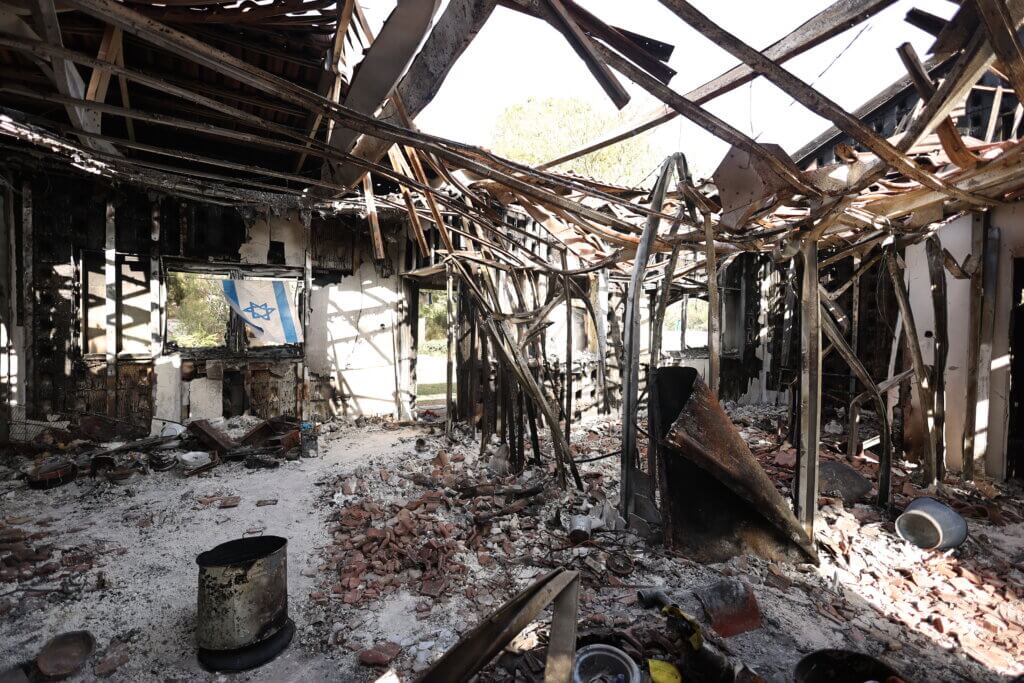We deserve the truth about what happened on October 7
Stories of atrocity on October 7 have been used to justify the ongoing assault on Gaza. But several of these high-profile claims have been found to be based on unreliable witnesses or even fabricated entirely. We deserve to know the truth.

In the immediate aftermath of the October 7 attacks by Hamas, narratives of atrocity dominated the news cycle. It is only now, four months later, that the events of that day are being clarified. The New York Times has reportedly pulled a high-profile podcast on the “weaponization” of rape in response to concerns of “major discrepancies.” Journalists are challenging state spokespeople, and researchers cross-referencing claims against the list of terror victims maintained by Israel’s own Social Security Administration have shown that several horrifying stories first responders and IDF members initially told reporters do not reflect actual people or deaths. The IDF itself has said it cannot confirm some of its own reporting.
Nevertheless, these stories spread widely. The founder of Oct7FactCheck.com saw how they impacted his friends and family. People who had previously protested Prime Minister Benjamin Netanyahu’s government were now insisting that “these people,” Palestinians in Gaza, were irredeemable. They cited the atrocities in the news as evidence.
And yet, it has become apparent that many of the stories used to justify ongoing violence in Gaza are just that: stories.
Oct7FactCheck.com is a six-member research group known collectively as “Nick Burbank.” The group, comprising an Ivy League law student, a policy graduate student, two intelligence analysts, a U.S. armed services veteran, and a tech entrepreneur, began fact-checking these claims in November. Their goal was to identify where a given claim originated, who propagated it, and whether the evidence confirmed or refuted the claim. Their findings are shared in a living document that’s updated as new information comes to light. Thus far, the team has come to conclusions on 12 different claims and identified major discrepancies in another: claims of weaponized rape that were reported on but are now being re-investigated by the New York Times.
To be clear:
There were no babies hung on clotheslines. There were no babies beheaded or put in ovens, no pregnant women with their stomachs cut open.
The sources responsible for those fabrications are cited in articles recounting the weaponized “mass rape” of Israeli women by Hamas fighters. Several stories shared by multiple outlets use these sources, raising open questions about the strength of this reporting. One January 19 Guardian article repeats the exact same language as an article published more than a month earlier on a different site. The New York Times article drew pushback on its reporting from the family of the victim they profiled, who argued she was not the victim of sexual violence; some of those family members have given new statements to the NYT.
Over the last four months, claims about October 7 have influenced the public narrative. Stories of atrocity, sometimes cobbled together from unreliable eyewitnesses, sometimes fabricated entirely, have made their way to heads of state and been used to justify Israel’s military violence.
As a result, 85% of Gaza is displaced. More than 26,000 Palestinians (including over 10,000 children have been killed), and nearly three times as many people have been injured. 70% of Gazan homes are flattened. Over 100 journalists have been killed. Every university in Gaza is now destroyed.
One of the claims determined to be definitively true is that IDF friendly fire on October 7 resulted in Israeli civilian deaths.
In the early hours of October 7, a deadly lack of communication made it difficult for Apache pilots and drone operators to distinguish targets, leading them to deputize civilians in the kibbutzim for target identification. But by noon on October 7, the Israeli military had issued a version of the “Hannibal Directive” (as reported to YNet, the second largest Israeli newspaper by readership, and translated by the Electronic Intifada). The Hannibal Directive is an order that allows Israeli forces to stop kidnappings at all costs, up to and including the death of the hostage if all else fails.
The order resulted in mass civilian deaths. Twopersonal accounts from civilians taken hostage on October 7 describe the IDF firing upon them while they were being kidnapped. In both instances, this resulted in the wounding or deaths of people they had been taken captive with, including one woman whose mother was killed. A similar report from YNet records the deployment of the Israeli Air Force to intercept 70 vehicles driven by Hamas militants as they returned to Gaza. The cars, some containing hostages, were destroyed before they could reach the border. An IDF military source reported that Israeli special forces were sent in the week after October 7 to recover bodies in this area. The number of Israeli dead found in these vehicles is currently not known.
One of the most chilling descriptions of friendly fire occurred in Be’eri, a kibbutz heavily damaged by the events of October 7. There, IDF forces killed up to 13 hostages in a single incident when they decided to fire two tank shells into a house controlled by militants, fully aware that there were still living civilians held captive inside. The IDF fired on the house during an active hostage negotiation. There were only two survivors, one woman who miraculously survived the shelling and Yasmin Porat, who had been released during the negotiations prior to the tank shells being fired. The shelling killed her husband, who remained under the control of the militants.
The aftermath of tank shelling looks very different from arson and small arms fire – there is more rubble, and less soot. In Be’eri, where fighting between IDF and militants was fiercest, homes were completely destroyed.Ha’aretz has reported that “half the damage” in Be’eri came from “munitions impacts,” the other half from “arson.” As a result, more than half of the 200 Israeli homes slated for demolition after the October 7 attack are located in Be’eri. In Nir Oz, where militants were not confronted by the IDF, houses were damaged mostly from arson.
Families of the victims are now calling for an investigation into the military and police units who were present and into whether or not the shelling of the house was an implementation of the Hannibal Directive. But initially, the commander responsible for firing a tank into a house full of hostages, General Barak Hiram, was hailed as a hero. Under the heading “A General’s Dilemma,” The New York Timesdescribes Hiram as “a rising star” before quoting him as ending an active hostage negotiation by saying, “Break in, even at the cost of civilian casualties.” Months later, additional reporting by the Times underscores the impact of the intentional use of IDF munitions by Hiram. This incident alone is responsible for 12% of the civilian casualties in Be’eri.1
It’s no secret that Israel invests heavily in “public diplomacy,” known commonly as hasbara. The incredible violence of their military offensive relies on the willingness of nations to prioritize Israeli narratives over Palestinian lives and, in the case of the Hannibal directive, Israeli lives as well. Stories of irredeemable atrocity – regardless of their truth – are essential to manufacturing the acceptability of harming civilians and building support for the Netayahu-led destruction of Gaza.
The small-t truth of these stories, the facts of what happened, is less important than the capital-T Truth these stories gesture to. In one example, a YouTube advertisement created by Israel’s Foreign Affair Minister begins with the words “We know that your child cannot read this” while rainbows and unicorns frolic to a lullaby. As the music grinds to a halt, the unicorns disappear and “Forty infants were murdered in Israel by the Hamas terrorists (ISIS),” flashes onto the screen” before urging parents, “Now hug your baby and stand with us.”
Business Insider reported on the way this ad and others were being used to justify Israel’s offensive in Gaza as early as October 17. That video is unlisted now, but the claim continues to be repeated. On January 2024, yet another video recycling the claims of ‘beheaded babies,’ this one propagated by the online antisemitism watchdog CyberWell, gasps in horror at the idea of Israeli atrocity propaganda being corrected. A person, scrolling online past a video debunking this same story of beheaded babies says “What? How can they even say that?”
This video does not defend the claim that babies were beheaded. It can’t. Social security records make this an impossibility. Instead, it appeals to the viewer’s sense of horror and outrage. While this specific instance may not be true, this advertisement gives the viewer permission to believe a broader, truthieraccusation: that Israel’s enemy is so depraved that such a thing could have happened then and may happen again in the future.
There were very real atrocities that happened on October 7, including the killing of civilians in their homes and at a music festival and the taking of hostages, some of them children. But somehow, the clearest crimes committed have been crowded out of the narrative in favor of obscene, attention-grabbing lies. This re-telling of the day is disrespectful to victims and survivors alike and only increases suspicion as to what really happened. It is a narrative that only serves those in power and those seeking to justify the genocidal assault on Gaza, not those rightfully seeking answers.
Notes
1. There are varying accounts of the number of those killed in Be’eri across different sources: 97 per the New York Times, 86 per Ha’aretz, 77 according to Social Security Administration records (but this may exclude captives later killed), and 98 per Oct7map.com. 12% represents the lower bound of the percentage of those killed attributable to the shelling of hostages.
BEFORE YOU GO – At Mondoweiss, we understand the power of telling Palestinian stories. For 17 years, we have pushed back when the mainstream media published lies or echoed politicians’ hateful rhetoric. Now, Palestinian voices are more important than ever.
Our traffic has increased ten times since October 7, and we need your help to cover our increased expenses.
Support our journalists with a donation today.



No comments:
Post a Comment